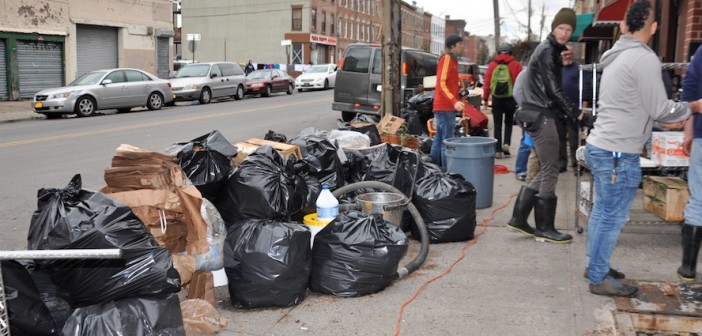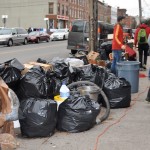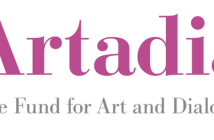Perhaps it's because I was born in New York City, perhaps it's the accumulation of devastating news and images or the growing list of grievances against FEMA, utility companies and local officials, voiced by inhabitants of the Rockaways, Staten Island, New Jersey and other areas struck hard by Hurricane Sandy, or perhaps it was the inspiring efforts of Occupy Sandy, CAAAV and other grassroots groups who repeatedly asked for help: whatever the reason, I went down to Brooklyn last weekend to pitch in with post-storm clean-up.
On the dot of 10, my friend Courtney, a resident of Kensington (Brooklyn), and I turned up—in our work-clothes, and carrying several bags of flashlights, batteries, gloves and masks—at the entrance to the Civil War-era waterfront warehouse from which The Redhook Initiative is organizing locally focused relief operations. On our way to the meeting point, the streets looked relatively clean and free of debris (piles of garbage bags lining the sidewalks are not that unusual in NYC), belying the true nature of the ongoing problems. To give you a sense of how the storm impacted Redhook, the water level surged 15 feet above sea level in 5 minutes, rushing down the streets like a tsunami. The watermark still lingers on the buildings 5 feet above street level and gushes out of the few basements where electricity is available to power pumps and dehumidifiers. Just yesterday @rhookinitiative tweeted this:
Shortage of volunteers today, shortage of hot meal donations. Still homes w/o power, hot water or heat! #SandyVolunteers we still need you.
Within minutes of signing in, we were being briefed on our first job and dispatched down Van Brunt Street to canvas local businesses about their immediate material needs. That day, the Redhook Initiative had some exciting news: the NYCEDC (Economic Development Corporation) needed help creating a database, matching Redhook businesses to suppliers poised to donate equipment necessary to get their doors open again. We were the messengers of these glad tidings and energetically headed up the street to meet local business owners and draw up a list of their material needs.
This is when Courtney and I met Ralph. We'd been knocking on one of those mysterious silver doors that looked like it could house some shady business as likely as not. He called out to us from across the street inquiring about what we wanted. We gave him the good news. He stared at us, then laughed. This wasn't a hearty ha-ha laugh, but more of a "you've got to be kidding me girlies" cackle tinged with latent anger.
Dorchester-native Ralph Gorham is the owner of the Redhook Lobster Pound which, he proudly told us, serves the best lobster roll south of Maine. That (and the fact that he looked like he might lose it any second) got my attention. Reluctantly he listed a couple of items, as we pressed him for a run-down of damaged equipment. Every sink, stove or freezer catalogued was followed by a disbelieving pause and an angry tirade at the continued absence of power (he had to threaten Con-Ed to have it turned on and most of his neighbors remain without it 12 days after the storm), the paltry FEMA loan offers ($20,000 when he lost close to $500,000 in materials alone), absent Red Cross and National Guard who are caught up in efforts in the Rockaways and Staten Island. So far, the clean-up assistance Ralph has received has been from volunteers dispatched by The Redhook Initiative. He's not complaining but he needs carpenters—and since his shop got flooded, he also needs table-saws, a planer and joiner on top of all the professional kitchen equipment, biologically balanced salt-water tanks and flooded food-trucks. Redhook Lobster Pound has started its own fundraiser on Smallknot and is using Twitter to reach out to potential volunteers.
Other business owners seemed more upbeat than Gorham, though Courtney and I both knew well by that point that this concealed exhaustion, heartbreak, anger and cynicism. Following our survey, we returned its results to the warehouse where now hundreds of volunteers were waiting in line (many in body-hugging outfits accessorized with what looked like brand-new neon sneakers, Gucci pocket-books slung across the shoulder). Outnumbered, we turned our efforts to the neighboring Brooklyn Waterfront Artists Coalition (BWAC) that had thrown its doors open in the hope of drying out some of the wetness seeped into the bicentennial stone walls. BWAC, Brooklyn's largest artist-run non-profit organization, began in 1978 and has reached a membership of over 500 artists. The entire ground floor gallery was filled during the first tidal surge, which bloated and destroyed hundreds of feet of sheetrock and furnishings (luckily the artwork had been evacuated).
Many of us artists possess skills essential to the recovery effort. At the very least, we can wield a hammer, saw or drill, can hang, spackle and paint drywall, and are self-motivated and focused workers. As I learned from last weekend's trip south, the work is far from over for the inhabitants and businesses hit by Hurricane Sandy. Amazing organizations are in place to help potential volunteers find work where they are most needed. Donations can be made online via Occupy Sandy's Wedding Registry, or directly via the various organizations' websites. Whatever you do, consider helping out in person or with your pocketbook.
- $50,000 worth of seafood trashed post-Sandy. Redhook Lobster Pound is trying to recover.





